The Top Built In Range Gurus Can Do Three Things
페이지 정보
작성자 Lela Carver 작성일25-03-05 10:13 조회3회 댓글0건관련링크
본문
Comprehending the Built-In Range: Built In Range oven A Deep Dive Into One of one of the most Versatile Programming Features
The built in oven uk-in function range() is among the most frequently utilized functions in programming, particularly in Python. Its simplicity and adaptability make it a necessary tool for designers, engineers, and information scientists alike. In this article, we will check out the essential aspects of the built-in range function, its syntax, usage cases, and some useful examples to assist you utilize its power in your coding ventures.
What is the Built-In Range?
In Python, the range() function produces a series of numbers. It is often utilized for version, [empty] particularly within loops, making it possible for developers to execute a block of code a specific variety of times without by hand defining each model.
Syntax of the Range Function
The range() function can take one, two, or three arguments, and its fundamental syntax is as follows:
 range( start, stop, action).
range( start, stop, action).
start: The beginning point of the sequence (inclusive). If omitted, integrated ovens Uk it defaults to 0.
stop: The endpoint of the series (exclusive). This argument is required.
step: The difference between each number in the sequence. If left out, it defaults to 1.
Examples of Using Range.
Fundamental Usage: Using range() in a basic for Build In Oven loop to print numbers from 0 to 4:.
for i in range( 5 ):.
print( i).
Output:.
0
1.
2.
3.
4.
Defining a Start and Stop: built in ovens for sale You can define both a beginning point and an endpoint:.
for i in range( 2, 6):.
print( i).
Output:.
2.
3.
4.
5.
Utilizing a Step Value: The action parameter permits you to control the increments:.
for i in range( 0, 10, 2):.
print( i).
Output:.
0
2.
4.
6.
8.
Counting Backwards: The step can likewise be unfavorable, enabling counting down:.
for i in range( 5, 0, -1):.
print( i).
Output:.
5.
4.
3.
2.
1.
Practical Applications.
Repeating Over Lists: While utilizing range() prevails in for loops, it can also be beneficial for iterating over the indices of a list.
fruits = [' apple', 'banana', 'cherry'] for i in range( len( fruits)):.
print( f" i: fruits [i] ").
Output:.
0: apple.
1: banana.
2: cherry.
Producing Number Sequences: The function comes in handy for generating sequences of numbers, which you might require for algorithms or data manipulation.
number_list = list( range( 10, 21)).
print( number_list).
Output:.
[10, 11, 12, 13, 14, 15, 16, 17, 18, 19, 20] List Comprehensions: range() works beautifully with list understandings for more condensed expressions.
squares = [x ** 2 for x in range( 5)] print( squares).
Output:.
[0, 1, 4, 9, 16] Conclusion.
The built-in range function is a basic feature in Python that provides a simple method to generate series of numbers, which can be utilized for a variety of programs jobs. Whether you are working on loops, generating lists, or implementing algorithms, comprehending how to make use of range() is important for reliable Python coding. As you continue to check out the language, you'll certainly find brand-new ways to take advantage of this powerful tool, making your shows jobs more effective and structured.
The built in oven uk-in function range() is among the most frequently utilized functions in programming, particularly in Python. Its simplicity and adaptability make it a necessary tool for designers, engineers, and information scientists alike. In this article, we will check out the essential aspects of the built-in range function, its syntax, usage cases, and some useful examples to assist you utilize its power in your coding ventures.
What is the Built-In Range?
In Python, the range() function produces a series of numbers. It is often utilized for version, [empty] particularly within loops, making it possible for developers to execute a block of code a specific variety of times without by hand defining each model.
Syntax of the Range Function
The range() function can take one, two, or three arguments, and its fundamental syntax is as follows:
 range( start, stop, action).
range( start, stop, action).start: The beginning point of the sequence (inclusive). If omitted, integrated ovens Uk it defaults to 0.
stop: The endpoint of the series (exclusive). This argument is required.
step: The difference between each number in the sequence. If left out, it defaults to 1.
Examples of Using Range.
Fundamental Usage: Using range() in a basic for Build In Oven loop to print numbers from 0 to 4:.
for i in range( 5 ):.
print( i).
Output:.
0
1.
2.
3.
4.
Defining a Start and Stop: built in ovens for sale You can define both a beginning point and an endpoint:.
for i in range( 2, 6):.
print( i).
Output:.
2.
3.
4.
5.
Utilizing a Step Value: The action parameter permits you to control the increments:.
for i in range( 0, 10, 2):.
print( i).
Output:.
0
2.
4.
6.
8.
Counting Backwards: The step can likewise be unfavorable, enabling counting down:.
for i in range( 5, 0, -1):.
print( i).
Output:.
5.
4.
3.
2.
1.
Practical Applications.
Repeating Over Lists: While utilizing range() prevails in for loops, it can also be beneficial for iterating over the indices of a list.
fruits = [' apple', 'banana', 'cherry'] for i in range( len( fruits)):.
print( f" i: fruits [i] ").
Output:.
0: apple.
1: banana.
2: cherry.
Producing Number Sequences: The function comes in handy for generating sequences of numbers, which you might require for algorithms or data manipulation.
number_list = list( range( 10, 21)).
print( number_list).
Output:.
[10, 11, 12, 13, 14, 15, 16, 17, 18, 19, 20] List Comprehensions: range() works beautifully with list understandings for more condensed expressions.
squares = [x ** 2 for x in range( 5)] print( squares).
Output:.
[0, 1, 4, 9, 16] Conclusion.
The built-in range function is a basic feature in Python that provides a simple method to generate series of numbers, which can be utilized for a variety of programs jobs. Whether you are working on loops, generating lists, or implementing algorithms, comprehending how to make use of range() is important for reliable Python coding. As you continue to check out the language, you'll certainly find brand-new ways to take advantage of this powerful tool, making your shows jobs more effective and structured.

댓글목록
등록된 댓글이 없습니다.
